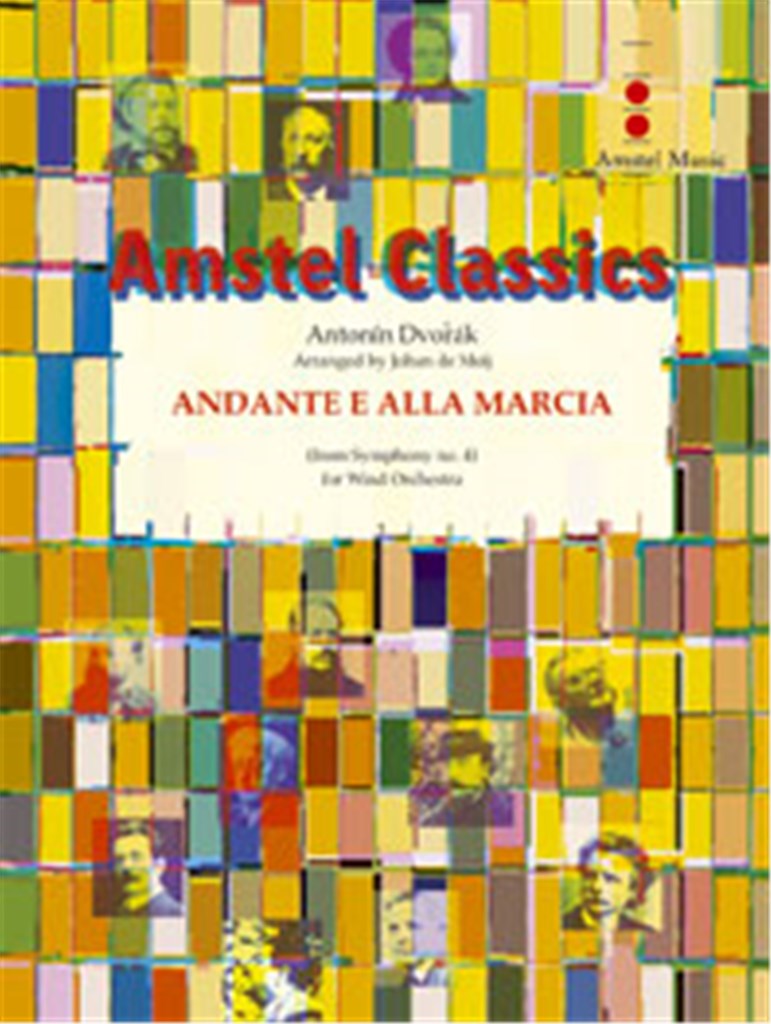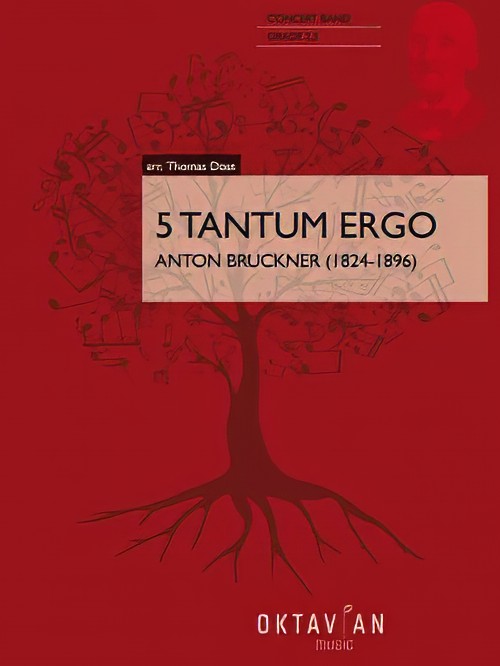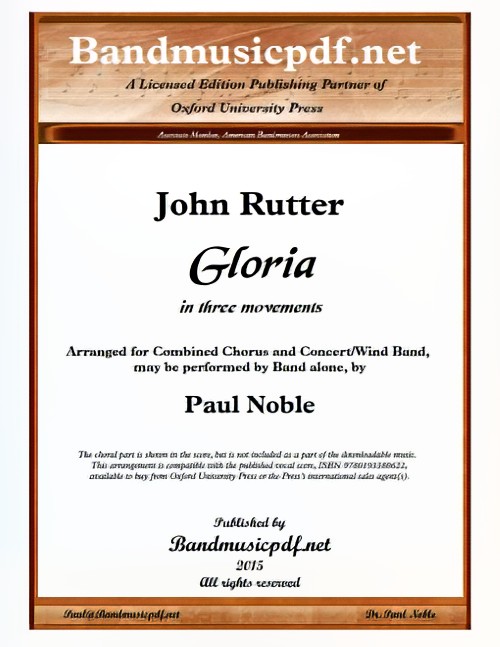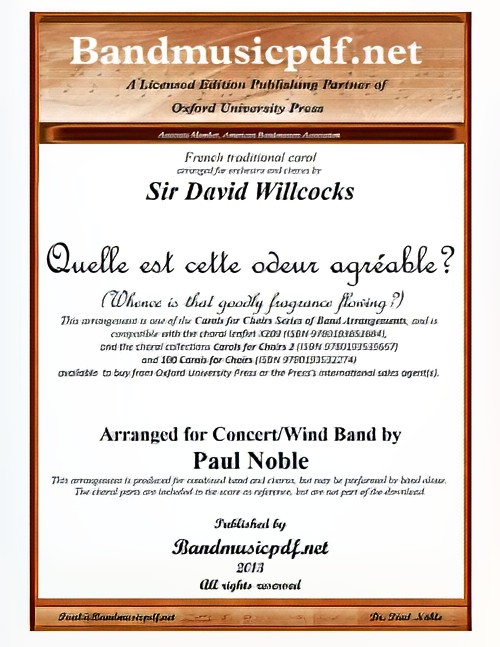Results
-
 £132.00
£132.00Andante e Alla Marcia (Concert Band - Score and Parts) - Dvorak, Antonin - De Meij, Johan
Dvorak's Symphony No.4 (1874) was a pivotal work in the career of this famous Bohemian composer. In the work Dvorak is finally freed from the influence of other composers and succeeds in producing a work in his own unique style. The slow introduction of the second movement (Andante sostenuto e molto cantabile) however clearly showed the influence of Wagner's Tannhauser, but the l'Alla Marcia du Scherzo is again typical Dvorak. You can also hear the obvious references to the traditional music of Bohemia which played an important part in late works of Dvorvak. A terrific classical work for your concert repertoire. Duration: 5.45
Estimated dispatch 7-14 working days
-
 £90.30
£90.30 -
 £104.99
£104.99Andante And Allegro - J.E. Barat
Estimated dispatch 7-14 working days
-
£78.99
An Irish Farewell - Larry Daehn
The lovely old tune on which this composition is based is know by a variety of names: "Farewell! But Whenever You Welcome the Hour," "To Rodney We Will Go," and "Moll Roone."The "Andante e rubato" used from the outset of the piece, gives conductors as much freedom as they might desire. Wonderful lyrical writing and a beautiful tribute to that special someone.
Estimated dispatch 7-14 working days
-
 £95.99
£95.995 Tantum Ergo (Concert Band - Score and Parts) - Bruckner, Anton - Doss, Thomas
Anton Bruckner (b. 4.9.1824, Ansfelden, d. 11.10.1896, Vienna) didn't have it easy. Throughout his life, the Austrian composer was plagued by self-doubt. Anton Bruckner came from a simple, rural background. After the death of his father, he was accepted as a choirboy at the monastery of Sankt Florian in 1837. After several years as a school assistant and his own organ and piano studies, he first worked as organist in St. Florian, then from 1855 as cathedral organist in Linz. Introduced to music theory and instrumentation by Simon Sechter and Otto Kitzler, he discovered Richard Wagner as an artistic role model, whom he admired throughout his life and also visited several times in Bayreuth. In 1868 Anton Bruckner became professor of basso continuo, counterpoint and organ at the Vienna Conservatory; ten years later court organist; and in 1891 finally honorary doctor of the University of Vienna. He was considered an important organ virtuoso of his era, but had to wait a long time for recognition as a composer. It was not until Symphony No.7 in E major, composed between 1881 and 1883, with the famous Adagio written under the effects of Wagner's death, that he achieved the recognition he had hoped for, even if he was reluctant to accept it given his inclination towards scepticism and self-criticism. Anton Bruckner was a loner who did not want to follow a particular school or doctrine. He composed numerous sacred vocal works, such as his three masses, the Missa Solemnis in B flat minor (1854), the Te Deum (1881-84) and numerous motets. As a symphonic composer, he wrote a total of nine symphonies and many symphonic studies from 1863 onwards, tending to revise completed versions several times over. Bruckner's orchestral works were long considered unplayable, but in fact were merely exceptionally bold for the tonal language of their time, uniting traditions from Beethoven through Wagner to folk music, on the threshold between late Romanticism and Modernism. Hymns for four-part mixed choir a cappella (1846, St. Florian) No. 1 in E flat major (WAB 41/3): Quite Slow No. 2 in C major (WAB 41/4): Andante No. 3 in B flat major (WAB 41/1): Slow No. 4 in A flat major (WAB 41/2): Slow Hymn for five-part (SSATB) mixed choir and organ No. 5 in D major: Solemnly They are simple works, completely subordinate to their liturgical use, which nevertheless already show numerous characteristics of personal expression. These small pieces were able to stand up to the harsh scrutiny of the mature master: in 1888, Bruckner subjected them to a revision in which he made only minor corrections.Duration: 11.00
Estimated dispatch 7-14 working days
-
 £295.00
£295.00Gloria (Concert Band with opt. Choir - Score and Parts) - Rutter, John - Noble, Paul
Gloria is one of Rutter's most ambitious concert works, and its premiere was the occasion for his first visit to the US, in May, 1974. Rutter himself sees this work as analogous to a symphony, with three movements-- allegro vivace, andante, vivace e ritmico--i.e., fast, slow, fast, in common with symphonic practice, and, says Rutter, "exalted, devotional and jubilant by turns". As with many of Noble's arrangements of John Rutter's compositions, this work is written for combined Chorus and Concert Band, but may be performed by Concert Band alone.
Estimated dispatch 7-14 working days
-
 £95.99
£95.995 Tantum Ergo - Anton Bruckner
Anton Bruckner (b. 4.9.1824, Ansfelden, d. 11.10.1896, Vienna) didn't have it easy. Throughout his life, the Austrian composer was plagued by self-doubt. Anton Bruckner came from a simple, rural background. After the death of his father, he was accepted as a choirboy at the monastery of Sankt Florian in 1837. After several years as a school assistant and his own organ and piano studies, he first worked as organist in St. Florian, then from 1855 as cathedral organist in Linz. Introduced to music theory and instrumentation by Simon Sechter and Otto Kitzler, he discovered Richard Wagner as an artistic role model, whom he admired throughout his life and also visited several times in Bayreuth.In 1868 Anton Bruckner became professor of basso continuo, counterpoint and organ at the Vienna Conservatory; ten years later court organist; and in 1891 finally honorary doctor of the University of Vienna. He was considered an important organ virtuoso of his era, but had to wait a long time for recognition as a composer. It was not until Symphony No.7 in E major, composed between 1881 and 1883, with the famous Adagio written under the effects of Wagner's death, that he achieved the recognition he had hoped for, even if he was reluctant to accept it given his inclination towards scepticism and self-criticism.Anton Bruckner was a loner who did not want to follow a particular school or doctrine. He composed numerous sacred vocal works, such as his three masses, the Missa Solemnis in B flat minor (1854), the Te Deum (1881-84) and numerous motets. As a symphonic composer, he wrote a total of nine symphonies and many symphonic studies from 1863 onwards, tending to revise completed versions several times over. Bruckner's orchestral works were long considered unplayable, but in fact were merely exceptionally bold for the tonal language of their time, uniting traditions from Beethoven through Wagner to folk music, on the threshold between late Romanticism and Modernism.Hymns for four-part mixed choir a cappella (1846, St. Florian)No. 1 in E flat major (WAB 41/3): Quite SlowNo. 2 in C major (WAB 41/4): AndanteNo. 3 in B flat major (WAB 41/1): SlowNo. 4 in A flat major (WAB 41/2): SlowHymn for five-part (2 S, A, T, B) mixed choir and organNo. 5 in D major: SolemnlyThey are simple works, completely subordinate to their liturgical use, which nevertheless already show numerous characteristics of personal expression. These small pieces were able to stand up to the harsh scrutiny of the mature master: in 1888, Bruckner subjected them to a revision in which he made only minor corrections.
Estimated dispatch 7-14 working days
-
 £75.00
£75.00Quelle est Cette Odeur Agreable (Whence is That Goodly Fragrance Flowing?) (Concert Band with Optional Choir - Score and Parts) - Noble & Willcocks
The original setting of this beautiful melody was for Strings and Chorus. This Concert/Wind Band version features the brass ensemble, the woodwind choir, as well as the full band. It is intended for combined Band and Chorus, but may be performed by Band alone. It is completely compatible with the published choral edition, except that it is written one-half step lower (E-flat instead of E major). There are no accidentals, and, apart from the instructions for andante and legato, the phrasing is left to the conductor. The simplicity and rich harmonic structure make this an important addition to the repertoire of young bands, and a perfect piece for any band to program for the Christmas season.
Estimated dispatch 7-14 working days
